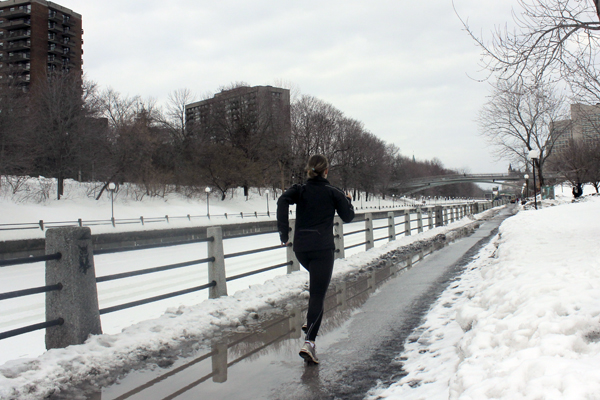It’s not just about layering up
Photo credit: Tina Wallace
As the chilling Ottawa cold creeps in, out come the Uggs and Canada Goose jackets and away go your running shoes, water bottle, and any trace of evidence that you run anywhere.
Fitness motivation has an annual tendency to quickly dissipate when the winter sets in, and for good reason. It’s easy to succumb to the winter blues and forget all about that hard-earned training regimen. Many of us hole up in our cozy rooms with some Netflix, hot chocolate, and articles about getting in shape that create the illusion that we are still on track with our fitness goals.
While you may continue running on the treadmill, there are still ways to get outside for a run that just may keep you from cringing at the snow in the window.
By far the hardest part of a workout is lacing up your shoes and getting out the door. Motivation, unlike bad Christmas music, is very hard to come by in the winter. An easy and fun way to get off the couch and out in the cold is to run in groups. If you prefer to run solo, try running to a specific destination such as a classroom or a restaurant (there’s nothing better than looking forward to a meal after a good workout).
Keep warm. Before heading out, a quick warm-up gets your blood flowing and makes for a less severe transition from inside to out. During your run, make sure you’re equipped with appropriate gear. Layering clothes will become necessary as temperatures drop.
When the temperature drops below 5 C, wear a base layer, an insulating layer, a windproof jacket, and always wear a hat, gloves, and a pair of thermal socks. A general rule of thumb is to wear an additional top and bottom layer for every time the weather drops five to 10 degrees colder.
Another key is to be warm without sweating too much. After your run, quickly changing into warm, dry clothes and drinking a warm drink will prevent your body temperature from dropping and keep you from getting sick. If it’s windy, begin your run facing the wind and finish with the wind at your back so the breeze doesn’t hit you after you’ve broken a sweat.
Running in the cold is very different than in the warmth, so you will need to adjust your usual running routine. Focus on your distance rather than your speed. Start slow and work your way up to a comfortable pace; this will prevent any injuries, and slow strides will help your footing on icy roads.
Most importantly, stay safe. Keep hydrated throughout your run, and keep your cell phone and cab fare with you in case of an emergency. Running in loops around your home is a safe way to start for beginners. If temperatures drop below –20, it may be worthwhile to take your run indoors.





